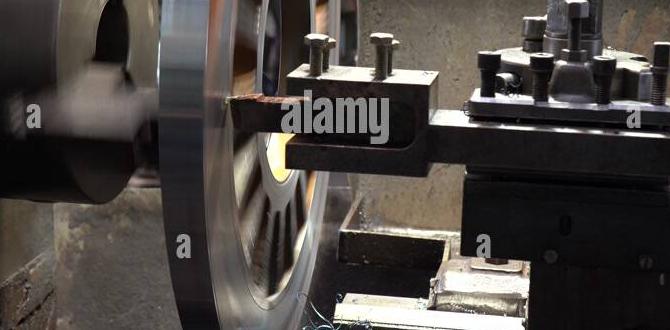A 1/8 inch carbide end mill, especially a long-reach 10mm shank model, is an excellent solution for reducing chatter when machining copper. The key lies in its rigidity, precision geometry, and optimized flute design, which minimize vibration and allow for smooth, clean cuts in this soft, gummy material.
Hey there, fellow makers! Daniel Bates here from Lathe Hub. If you’ve ever worked with copper on a mill, you’ve probably battled that annoying, squealing vibration we call “chatter.” It leaves nasty marks on your workpiece and makes for a frustrating experience. It’s a common hiccup when milling softer metals like copper, but don’t worry – there’s a straightforward fix. Today, we’re diving deep into how a specific tool, the 1/8 inch carbide end mill, can be your secret weapon against this machining menace. Get ready to discover how this small but mighty tool can help you achieve smooth, chatter-free copper cuts and boost your confidence at the milling machine.
Why Does Copper Chatter So Much?
Copper is a fantastic material for many projects – it conducts electricity and heat well, it’s easy to solder, and it has a beautiful look. However, when it comes to milling, copper can be a bit… stubborn. It’s soft and ductile, meaning it tends to deform rather than chip cleanly. This gummy nature is the root cause of many machining frustrations, especially chatter.
Imagine trying to cut through play-doh with a dull knife. As you push, the play-doh squishes and deforms, making it hard to get a clean cut. In a milling operation, this is what happens with copper. The cutting tool encounters resistance, and instead of smoothly shearing away material, it can grab and pull. This uneven engagement causes vibrations to build up, leading to that distinctive, unpleasant chatter sound and finish. These vibrations can damage the tool, the workpiece, and even the machine if they become severe.
Several factors contribute to this:
- Material Softness: Copper’s low hardness means it can easily deform, leading to smeared chips and inconsistent cutting forces.
- Gummy Tendency: Instead of breaking into small chips, copper tends to form long, stringy ones that can recut and interfere with the cutting process.
- Low Rigidity: In thin or delicate copper parts, the material itself can flex and vibrate, amplifying chatter.
- Tooling Choices: Using the wrong type of end mill or dull tooling exacerbates the problem.
The Right Tool for the Job: The 1/8 Inch Carbide End Mill
So, how do we combat this? The key is in selecting the right tool. For milling copper, and specifically for tackling chatter, a 1/8 inch carbide end mill, especially one with features designed for softer materials, becomes invaluable. Let’s break down why:
What Makes Carbide Special?
Carbide, short for tungsten carbide, is a super-hard material composed of tungsten and carbon. It’s significantly harder and more wear-resistant than High-Speed Steel (HSS), which is often used for cutting tools. This hardness is crucial for a few reasons:
- Edge Retention: Carbide tools maintain a sharp edge for much longer than HSS, even at higher cutting speeds and temperatures. This sustained sharpness is vital for consistent cutting.
- Rigidity: Carbide is a denser, more rigid material than HSS. This means the tool itself is less likely to flex or vibrate during cutting, which directly combats chatter.
- Heat Resistance: While copper isn’t the hardest material, the friction from cutting can still generate heat. Carbide handles this heat much better than HSS, preventing the cutting edge from softening and dulling prematurely.
Why 1/8 Inch?
The 1/8 inch diameter is a versatile size for many detailed machining tasks. For copper, it allows for fine feature work and precise cuts. When dealing with chatter, a smaller diameter can sometimes be more forgiving because the cutting forces are lower. However, the true benefit of a 1/8 inch carbide end mill for chatter reduction comes from its combination of size, material, and specific design features.
The Importance of a 10mm Shank
You might see “1/8 Inch Carbide End Mill” and think, “Okay, that’s the cutting diameter.” But what about the shank? For improved stability and reduced vibration, a 10mm shank is a significant advantage over a standard 6mm or 1/4 inch shank for a 1/8 inch cutter. Here’s why:
- Increased Rigidity: A larger shank diameter (like 10mm) provides more mass and stiffness. When mounted in a collet or tool holder, a thicker shank creates a more robust connection to the spindle. This connection is less prone to flexing or vibrating, which is exactly what we need to fight chatter. Think of it like using a thicker stud for a shelf – it supports more weight and wobbles less.
- Reduced Runout and Deflection: A well-machined 10mm shank, held securely in a quality collet system, contributes to lower overall runout (the wobbling of the cutting head). Less runout means more consistent engagement with the material, and less chance for the tool to deflect under load, both of which are critical for chatter-free machining.
- Better Heat Dissipation: While not its primary function, a larger shank can also help dissipate some of the heat generated during cutting away from the cutting edge, further contributing to tool life and cut quality.
Specialized Geometries for Copper
Not all 1/8 inch carbide end mills are created equal. For copper, specific flute designs are crucial for chatter reduction:
- High Positive Rake Angle: This is perhaps the most important geometric feature for soft, gummy materials like copper. A high positive rake angle means the cutting edge is presented to the material at a very keen, sharp angle. This “slices” the material rather than “pushing” it, resulting in lower cutting forces and cleaner chip formation. It’s like using a sharp chef’s knife to slice a tomato versus a serrated bread knife.
- Polished or Bright Finishes: End mills designed for aluminum and copper often have highly polished flutes. This smooth surface helps chips flow away from the cutting zone easily, preventing material buildup (known as “Bird-mouthing” or “Cusping”) on the cutting edges, which can cause chatter and poor surface finish.
- Single Flute vs. Multiple Flutes: While more flutes can remove material faster, they often lead to more chatter in soft materials. For copper and chatter reduction, a single-flute or sometimes a two-flute end mill with a wide, polished chip evacuation gullet is often preferred. A single flute has more space to clear chips and less tendency to “grab” the material.
- Variable Helix or Pitch: Some high-performance end mills feature a variable helix angle or variable pitch between flutes. This subtle design variation helps break up resonant frequencies, making it harder for chatter to establish itself and propagate.
When selecting your 1/8 inch carbide end mill for copper, look for descriptions mentioning “aluminum,” “soft metal,” “plastic,” or “free machining” applications. These tools are often designed with the high rake, polished flutes, and chip clearance needed to conquer copper’s gummy nature and minimize chatter.
Setting Up for Success: Preventing Chatter Before You Cut
Even with the perfect tool, proper machine setup and technique are vital. Think of it as preparing the stage for your star performer – the end mill!
Machine Rigidity is Key
The most rigid setup often provides the best results. Here’s how to ensure your milling machine is ready:
- Well-Maintained Machine: Ensure your milling machine is in good working order. Check for play in the table, knee, and spindle bearings. Loose components amplify vibrations.
- Secure Workholding: This is paramount. Your workpiece must be clamped down TIGHTLY. Use proper clamps, T-nuts, and consider sub-plates for added rigidity. A wobbly workpiece will guarantee chatter. For copper, which is soft, it’s easy to crush thin parts with clamps, so use clamping strategies that distribute pressure evenly or clamp on thicker sections.
- Minimize Z-Axis Overhang: Whenever possible, keep the distance between the spindle face and the top of your workpiece as short as you can. A longer tool sticking out of the collet has more opportunity to flex and vibrate. A 1/8 inch end mill, even with a 10mm shank, shouldn’t have excessive stick-out.
- Clean Tool Holder and Collet: Ensure your collet and the tool holder (if used) are spotlessly clean. Even a tiny bit of swarf or coolant residue can cause the tool to run out slightly, leading to inconsistent cuts and chatter.
Spindle Settings: Speed and Feed Matter
Getting your spindle speed (RPM) and feed rate right for copper is like finding the sweet spot on an instrument. Too fast, too slow, or misaligned, and you get noise (chatter).
Surface Speed and RPM Calculation
Surface speed, usually measured in surface feet per minute (SFM) or meters per minute (m/min), is the speed at which the cutting edge is moving through the material. Different materials and tool types have optimal SFM ranges. For copper, and especially with carbide end mills, SFM can be quite high.
A good starting point for carbide end mills in copper is often in the range of 200-400 SFM (60-120 m/min). Always consult the tool manufacturer’s recommendations if available.
You can calculate the spindle RPM using the following formula:
RPM = (SFM × 3.82) / Diameter (inches)
or
RPM = (m/min × 1000) / (π × Diameter (mm))
Let’s calculate for a 1/8 inch (0.125 inch) carbide end mill, aiming for 300 SFM:
RPM = (300 × 3.82) / 0.125
RPM = 1146 / 0.125
RPM = 9168
So, around 9000-10000 RPM is a good starting point. You might need to adjust this based on your machine’s capabilities and the specific alloy of copper you’re using.
Feed Rate: The Key to Chip Formation
The feed rate (how fast the tool advances into the material, usually in inches per minute or millimeters per minute) is crucial for creating good chips. For soft materials like copper, you want a feed rate that is aggressive enough to create a proper chip, but not so aggressive that it overloads the tool or causes deflection.
A “chip load” is the thickness of the material removed by each cutting edge on each revolution. For a 1/8 inch end mill, a chip load might range from 0.001 to 0.003 inches (0.025 to 0.075 mm).
Feed Rate (IPM) = Chip Load (inches/tooth) × Number of Flutes × RPM
Let’s say we’re using a 2-flute end mill at 9000 RPM with a target chip load of 0.002 inches per tooth:
Feed Rate = 0.002 inches/tooth × 2 flutes × 9000 RPM
Feed Rate = 36 inches per minute (IPM)
This is a starting point. If you hear chatter, you might need to increase the feed rate slightly to get the tool moving faster relative to its cutting action, or decrease it if the tool is “plowing” through the material.
Common Misconception: High Feed Rate for Soft Materials
Many beginners think that because copper is soft, you should feed very slowly. This is often the opposite of what’s needed for chatter reduction. Feeding too slowly can lead to the tool rubbing instead of cutting, creating heat and dulling the edge, which triggers chatter. You want to feed fast enough to ensure each flute takes a decent “bite” (that chip load) and clears the material effectively.
Coolant and Lubrication
While not always mandatory for copper, using a coolant or cutting fluid can significantly improve your results:
- Chip Evacuation: Lubricants help flush chips away from the cutting zone, preventing them from re-cutting and causing a poor finish or snagging.
- Temperature Control: They help keep the cutting edge cool, reducing tool wear and preventing material buildup.
- Friction Reduction: Lubricants reduce friction between the tool and the workpiece, leading to smoother cuts.
For copper, a general-purpose cutting fluid designed for aluminum or non-ferrous metals works well. Avoid oils with high sulfur content, as they can sometimes react with copper.
Step-by-Step: Machining Copper with Your 1/8 Inch Carbide End Mill
Let’s walk through a typical milling operation. We’ll assume you’re using a CNC mill or a manual mill with DROs (Digital Readouts).
- Prepare Your Machine:
- Ensure the milling machine is cleaned, lubricated, and all axes move smoothly.
- Check and tighten any gibs or ways that might have play.
- Secure the Workpiece:
- Place your copper stock firmly on the milling table.
- Use appropriate clamps (e.g., edge clamps, strap clamps) to hold the workpiece securely. Ensure clamps are not in the path of the tool.
- Tap the workpiece lightly with a mallet after clamping to seat it properly against the parallels or fixture.
- Install the End Mill:
- Clean the collet and the tool holder (if applicable).
- Insert the 1/8 inch carbide end mill into the collet, ensuring it’s seated properly. The 10mm shank should provide a firm grip.
- Tighten the collet securely in the tool holder or directly into the spindle.
- Check tool stick-out – aim for the shortest practical length.
- Set Up Zero and Machine Zero:
- With the spindle OFF, carefully bring the cutting edge of the end mill down to the top surface of your workpiece using the Z-axis handwheel or by jogging the CNC.
- Touch off your Z-axis zero point here.
- Set your X and Y axis zeros according to your CAD/CAM program or manual machining plan.
- Input Cutting Parameters:
- Calculate your RPM and feed rate. For a 1/8 inch, 2-flute carbide end mill in copper, a good starting point might be:
- RPM: 9,000 – 10,000
- Feed Rate: 25 – 40 IPM (or 0.0015 – 0.0025″ chip load)
- Depth of Cut (DOC): Start conservatively, perhaps 0.050″ – 0.100″. For roughing, you might go deeper, but for chatter-prone operations, shallower is often better initially.
- Stepover: For profiling, a stepover of 0.050″ – 0.100″ is a good starting point. For pocketing, this will be controlled by the pocket width.
- Calculate your RPM and feed rate. For a 1/8 inch, 2-flute carbide end mill in copper, a good starting point might be:
- Apply Coolant (if used):
- Start your coolant flow or mist before starting the spindle.
- Start the Spindle:
- Turn on the spindle to the calculated RPM. Listen for any unusual noises.
- Begin the Cut:
- Initiate the feed rate.
- Listen and Watch: This is the most critical part of preventing chatter.
- If you hear chatter:
- Try increasing the feed rate slightly (e.g., by 10-15%).
- Try decreasing the depth of cut.
- Try increasing the spindle speed slightly if you are not at your machine’s maximum limit.
- Check your workholding – is the part vibrating?
- Ensure your tool isn’t worn.
- If using a manual mill, ensure you’re engaging the feed smoothly and consistently, not jerky.
- Consider a slight increase in stepover if you’re clearing a pocket – sometimes reducing the chip load per pass is better than trying to take too much material.
- If the cut is smooth:
- Gradually increase your depth of cut or stepover while maintaining the feed rate until you find the limit where chatter begins. Back off slightly from that
- Gradually increase your depth of cut or stepover while maintaining the feed rate until you find the limit where chatter begins. Back off slightly from that







